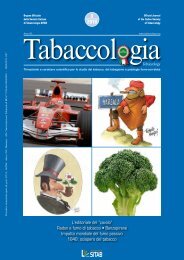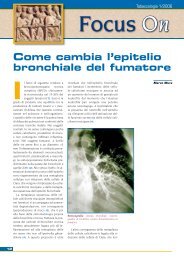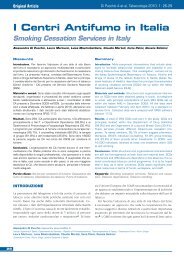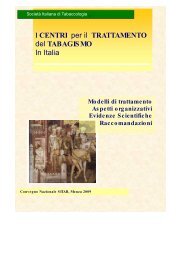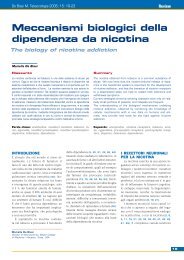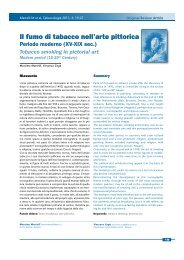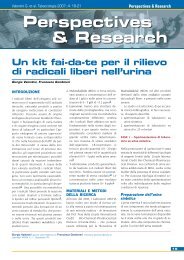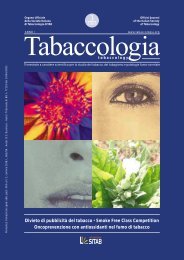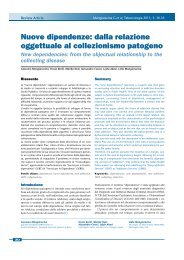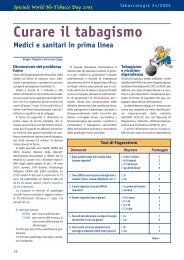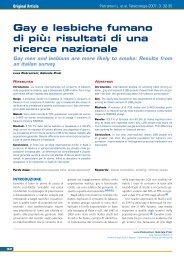Scarica n. 1/2011 - Società Italiana di Tabaccologia
Scarica n. 1/2011 - Società Italiana di Tabaccologia
Scarica n. 1/2011 - Società Italiana di Tabaccologia
Create successful ePaper yourself
Turn your PDF publications into a flip-book with our unique Google optimized e-Paper software.
16<br />
Original Article Research<br />
la gente pensi, e milioni <strong>di</strong> persone sono<br />
quoti<strong>di</strong>anamente esposti ad esso per motivi<br />
molto meno intriganti che non quelli legati<br />
allo spionaggio: circa 5,7 bilioni (10 12 ) <strong>di</strong> sigarette<br />
vengono infatti fumate ogni giorno<br />
e ognuna <strong>di</strong> esse contiene me<strong>di</strong>amente 0,04<br />
picocurie <strong>di</strong> polonio 210. Questo, fumata<br />
dopo fumata, si accumula con un dosaggio<br />
<strong>di</strong> ra<strong>di</strong>azioni equivalente a 300 ra<strong>di</strong>ografie<br />
per un fumatore <strong>di</strong> un pacchetto e mezzo <strong>di</strong><br />
sigarette in un anno. [1]. 1<br />
Le multinazionali del tabacco sanno che,<br />
data la presenza <strong>di</strong> polonio nei loro prodotti da quasi 50<br />
anni, prima o poi potrebbe essere richiesto loro <strong>di</strong> eliminarlo,<br />
o almeno ridurne la concentrazione negli stessi. Benché<br />
poco noto al grande pubblico, il polonio spicca tra i molti<br />
agenti cancerogeni e pericolosi presenti nel tabacco.<br />
Gli “Hot spot”<br />
Durante i primi anni ’60, ricercatori del laboratorio <strong>di</strong> ricerca<br />
ra<strong>di</strong>ochimica della Harvard School of Public Health<br />
iniziava a preoccuparsi delle conseguenze delle ra<strong>di</strong>azioni<br />
e della ricaduta ra<strong>di</strong>oattiva sulla salute della gente. All’epoca<br />
Vilma Hunt si occupava dell’attività del laboratorio e<br />
insieme ai suoi colleghi era al lavoro per sviluppare una<br />
metodologia che fosse in grado <strong>di</strong> accertare la presenza <strong>di</strong><br />
livelli molto bassi <strong>di</strong> polonio e <strong>di</strong> ra<strong>di</strong>o. La Hunt, che in<br />
quel periodo si occupava <strong>di</strong> ra<strong>di</strong>oisotopi, posò per caso lo<br />
sguardo sulla cenere della sigaretta <strong>di</strong> uno dei suoi colleghi<br />
e, senza un motivo particolare, decise <strong>di</strong> eseguire un test<br />
per rilevare in essa la presenza <strong>di</strong> polonio e <strong>di</strong> ra<strong>di</strong>o. Non<br />
ricorda perché lo fece; come mi <strong>di</strong>sse nel corso <strong>di</strong> una conversazione<br />
telefonica, fu solo perché “il suo cervello quel<br />
giorno funzionava così”. [2,3]. 2<br />
Quando ebbe i risultati, fu stupita nel non trovare presenza<br />
<strong>di</strong> polonio nella cenere. Nessun materiale organico,<br />
anche <strong>di</strong> origine vegetale, era mai risultato negativo per<br />
il polonio, se vi era presenza <strong>di</strong> ra<strong>di</strong>o. Da qualche parte<br />
nella sua mente, aveva presente il valore della temperatura<br />
<strong>di</strong> combustione delle sigarette e <strong>di</strong> vaporizzazione del<br />
polonio, per cui, esaminando quei risultati, improvvisamente<br />
ebbe l’idea che il polonio potesse essere “andato in<br />
fumo”! Da quel momento i suoi interessi si focalizzarono<br />
sui ra<strong>di</strong>oisotopi contenuti nel tabacco. Pubblicò le sue scoperte,<br />
assieme al suo collega <strong>di</strong> Harvard, Edward Radford,<br />
pochi mesi dopo, precisamente nel numero <strong>di</strong> Science del<br />
17 Gennaio del 1964. [2-4].<br />
La ricerca <strong>di</strong> Radford e Hunt verteva sulla misurazione<br />
della ra<strong>di</strong>oattività presente nelle sigarette e nel fumo.<br />
Il loro collega <strong>di</strong> Harvard, John (“Jack”) Little, me<strong>di</strong>co e<br />
( 1) Il curie (Ci) misura la quantità <strong>di</strong> ra<strong>di</strong>azione: 1 Ci = 3,7 × 10 10 deca<strong>di</strong>menti/secondo<br />
(o l’attività <strong>di</strong> 1 grammo <strong>di</strong> ra<strong>di</strong>o-226).<br />
( 2) il Ra<strong>di</strong>o-223 si forma dall'uranio-235, il ra<strong>di</strong>o-226 si forma dal torio-232,<br />
e il ra<strong>di</strong>o-224 (un isotopo parente del polonio-210) si forma<br />
dall'uranio-238<br />
Rego B, <strong>Tabaccologia</strong> <strong>2011</strong>; 1: 15-22<br />
lions are exposed to it every day through<br />
something much more mundane than<br />
espionage: about 5.7 trillion cigarettes<br />
are smoked annually worldwide and each<br />
one of those contains 0.04 picocuries of<br />
polonium-210. Puff by puff this builds up<br />
to the equivalent ra<strong>di</strong>ation dosage of 300<br />
chest x-rays per year for a smoker with<br />
a daily habit of one and a half packs of<br />
cigarettes [1] [1]. 1 Tobacco manufacturers<br />
Brianna Rego<br />
have known about polonium in cigarettes<br />
for nearly fifty years, and have long been<br />
aware that they might eventually be called upon to remove<br />
it from their product, or at least reduce its concentration.<br />
Largely unknown to the general public, polonium<br />
lurks among the many carcinogens and hazardous<br />
ingre<strong>di</strong>ents of tobacco.<br />
Hot spots<br />
During the early 1960s, scientists in the ra<strong>di</strong>ochemical<br />
research lab at the Harvard School of Public Health were<br />
concerned with the health effects of ra<strong>di</strong>ation and ra<strong>di</strong>oactive<br />
fallout. At the time, ra<strong>di</strong>ochemist Vilma Hunt was<br />
in charge of lab activity, and she worked with colleagues to<br />
develop a methodology for chemical analysis of very low<br />
levels of ra<strong>di</strong>um and polonium. Hunt therefore constantly<br />
had ra<strong>di</strong>oisotopes on her mind when one day her gaze was<br />
wandering around the lab and paused on the cigarette ash<br />
of one of her colleagues. On a whim, she decided to test<br />
the ash for polonium and ra<strong>di</strong>um. She does not remember<br />
why she thought to run that test; it was, she told me in a<br />
telephone conversation, just “the way her brain worked<br />
that day” [2, 3] 3]. 2<br />
When she got the measurements back, she was astonished<br />
to <strong>di</strong>scover there was no polonium in the ash<br />
sample. No other organic material, inclu<strong>di</strong>ng plants, had<br />
tested negative for polonium when ra<strong>di</strong>um was present.<br />
She knew in the back of her mind the volatile temperature<br />
of both polonium and cigarettes, so as she pondered<br />
her lab notes, she suddenly thought that the polonium<br />
must have gone up in smoke! In that moment her interests<br />
snapped to ra<strong>di</strong>oisotopes in tobacco. A few months<br />
later, along with her colleague at Harvard, Edward Radford,<br />
Hunt published her fin<strong>di</strong>ng in the January 17, 1964<br />
issue of Science [2-4] [2-4].<br />
Radford and Hunt’s research was focused on measuring<br />
ra<strong>di</strong>oactivity in cigarettes and smoke. Their colleague at<br />
Harvard, ra<strong>di</strong>obiologist and physician John (“Jack”) Little,<br />
conducted a study of human lung tissue and showed in<br />
1965 that polonium was, in fact, deposited and collected<br />
( 1) The curie (Ci) measures the actual amount of ra<strong>di</strong>ation: 1 Ci = 3.7 x<br />
x 10 10 decays/second (or the activity of 1 gram of ra<strong>di</strong>um-226). A picocurie<br />
(pCi) is one trillionth (10 –12 ) of a curie.<br />
( 2) Ra<strong>di</strong>um-223 decays from uranium-235, ra<strong>di</strong>um-226 decays from<br />
thorium-232, and ra<strong>di</strong>um-224 (a parent isotope of polonium-210) decays<br />
from uranium-238.



